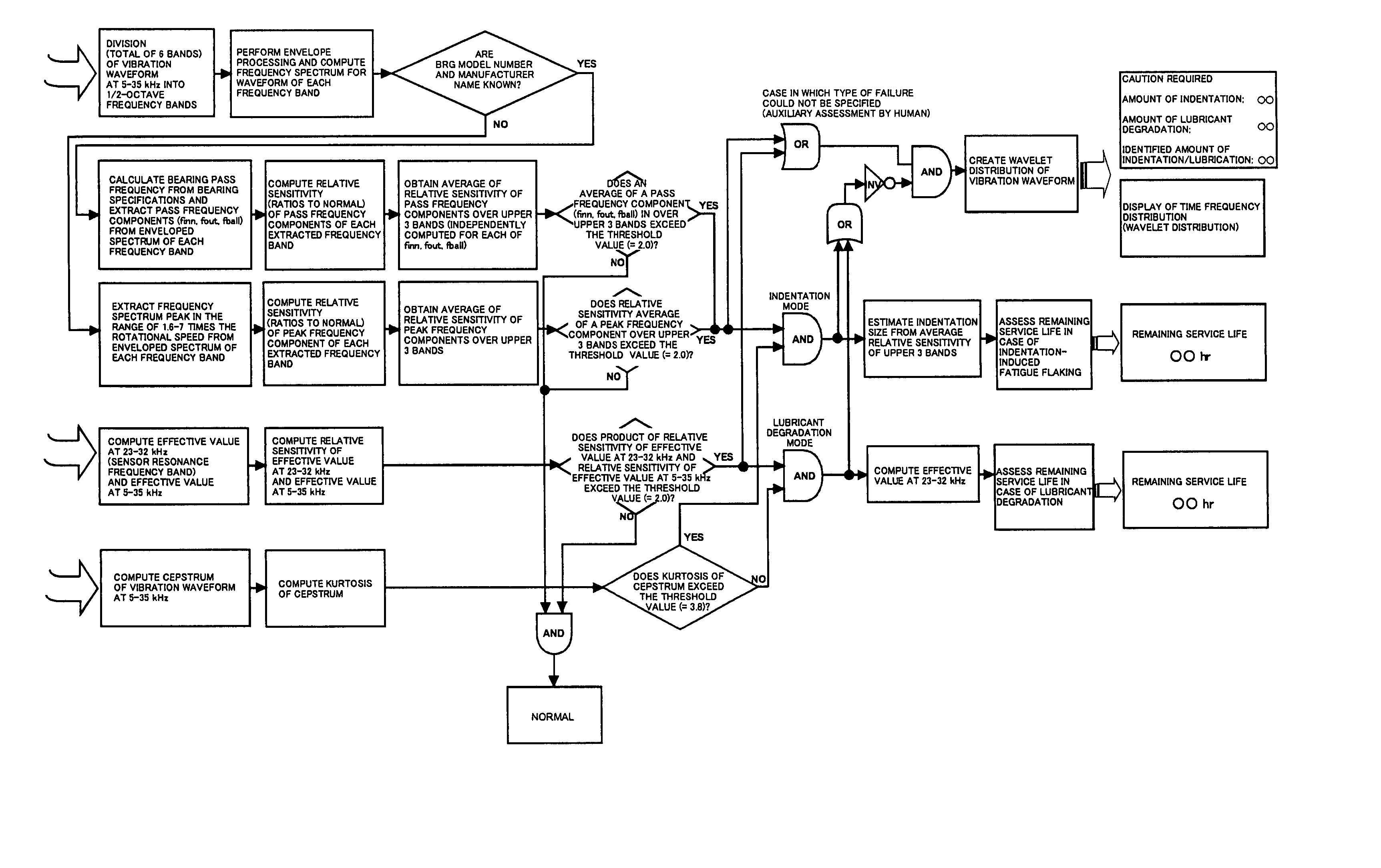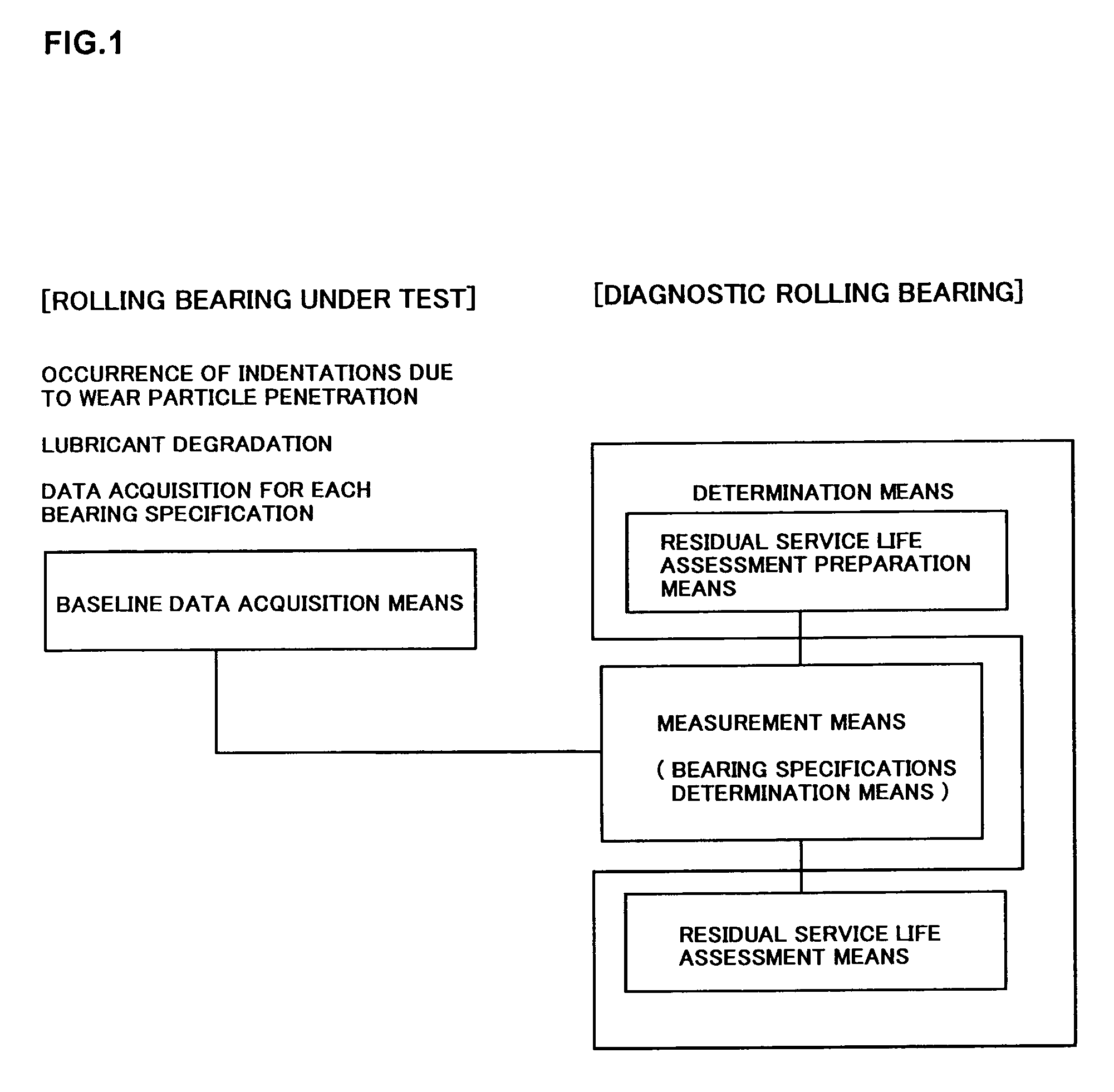Method And Device For Assessing Residual Service Life Of Rolling Bearing
a technology of residual service life and rolling bearing, which is applied in the direction of fluid pressure measurement by mechanical elements, solid vibration measurement, machine part testing, etc., can solve the problems of increased vibration, unbalance or misalignment of rolling bearings, and affect the service life of these rolling bearings, and achieves the effect of higher precision
- Summary
- Abstract
- Description
- Claims
- Application Information
AI Technical Summary
Benefits of technology
Problems solved by technology
Method used
Image
Examples
first embodiment
[0093] Preferred embodiments of the present invention will be described hereinafter with reference to the drawings.
[0094]FIG. 1 is a block diagram illustrating the method for assessing the remaining service life of a rolling bearing according to the present invention. FIG. 2 is a sectional view of an example of rolling bearings residing on an electric motor and a rotating device as the objects for assessment according to the method for assessing remaining service life.
[0095] To obtain baseline data in the baseline data acquisition means, scratches are made directly on the rolling contact surfaces of disassembled bearings to simulate wear particle penetration, resulting in the appearance of indentations on the bearings. To simulate lubricant degradation, bearings having reduced lubricant volumes are then used in tests with a load testing device. An alternative method for simulating wear particle penetration is to introduce a foreign substance into the lubricant in place of wear par...
second embodiment
[0113]FIG. 4 is a flowchart illustrating the method for assessing the remaining service life of a rolling bearing in which the model number and name of the manufacturer of the rolling bearing of a second embodiment are determined. FIG. 5 is a flowchart illustrating the method for assessing the remaining service life of a rolling bearing according to a quantitative feature of indentation when the bearing specifications are determined. FIG. 6 is a flowchart illustrating the method for assessing the remaining service life of a rolling bearing according to a quantitative feature of indentation when the bearing specifications are not determined.
[0114] A description is provided of a method for detecting indentation that determines specifications such as the model number and the name of the manufacturer of the rolling bearing (3) of the second embodiment.
[0115] The model number and the name of the manufacturer of the diagnostic rolling bearing (3) are determined by dividing the vibration...
third embodiment
[0154]FIG. 11 is a block diagram of the structure of the device for assessing the remaining service life of a rolling bearing according to the present invention.
[0155] The device for assessing the remaining service life of a rolling bearing has an accelerometer (4), an analog / digital converter (5), a quantitative feature extraction unit (6), a measurement results database (7), a residual service life assessment unit (8), and an assessment results display (9), as well as an output unit for inspection schedules and diagnostic reports (10), and a transmission modem (11).
[0156] The analog / digital converter (5) converts data obtained by the accelerometer (4) on, e.g., a diagnostic rolling bearing (3) whose remaining service life is to be assessed as described above. The quantitative feature extraction unit (6) detects from among the vibration signals converted by the analog / digital converter (5) those signals in the resonance frequency band that are detectable at the highest sensitivit...
PUM
 Login to View More
Login to View More Abstract
Description
Claims
Application Information
 Login to View More
Login to View More - R&D
- Intellectual Property
- Life Sciences
- Materials
- Tech Scout
- Unparalleled Data Quality
- Higher Quality Content
- 60% Fewer Hallucinations
Browse by: Latest US Patents, China's latest patents, Technical Efficacy Thesaurus, Application Domain, Technology Topic, Popular Technical Reports.
© 2025 PatSnap. All rights reserved.Legal|Privacy policy|Modern Slavery Act Transparency Statement|Sitemap|About US| Contact US: help@patsnap.com



